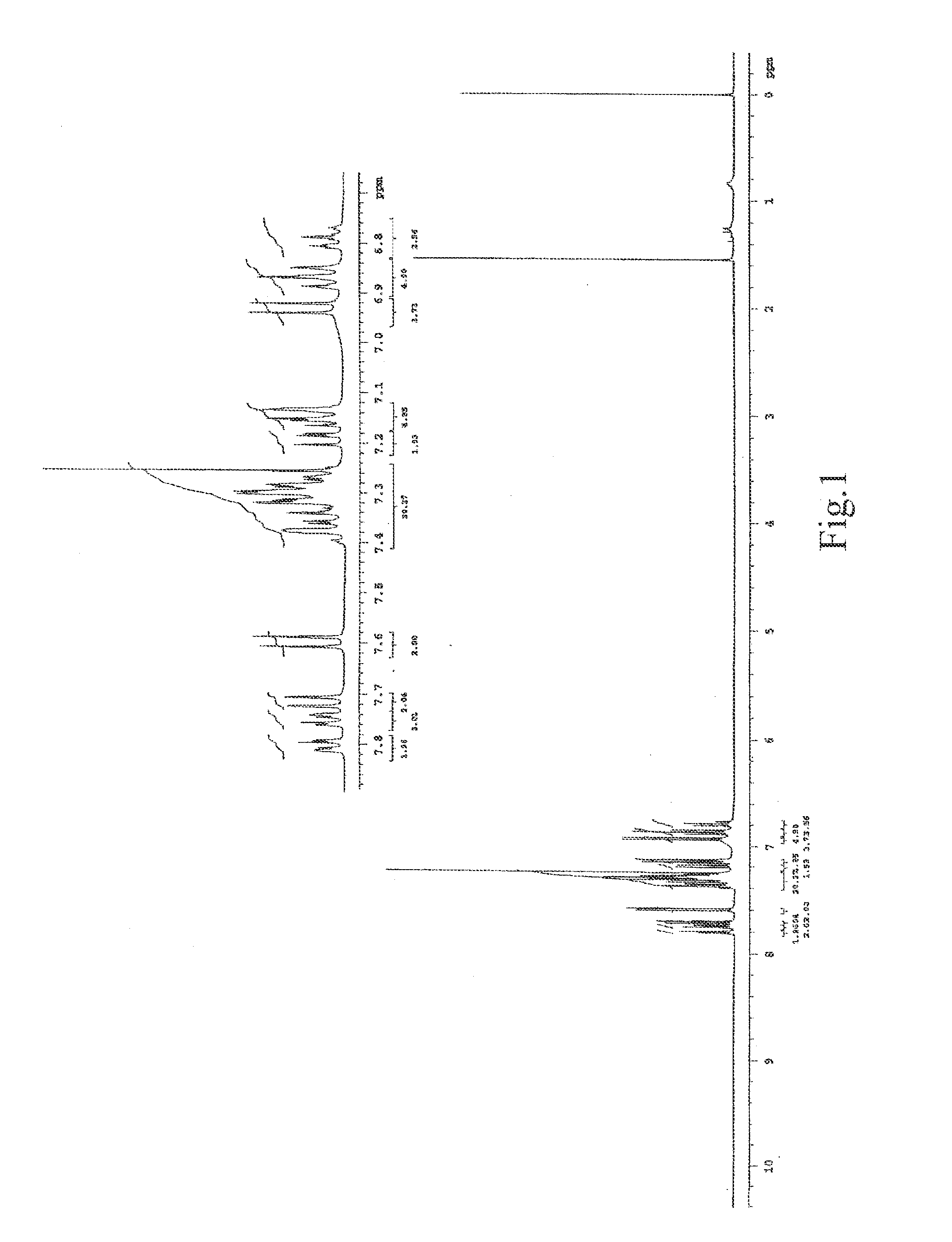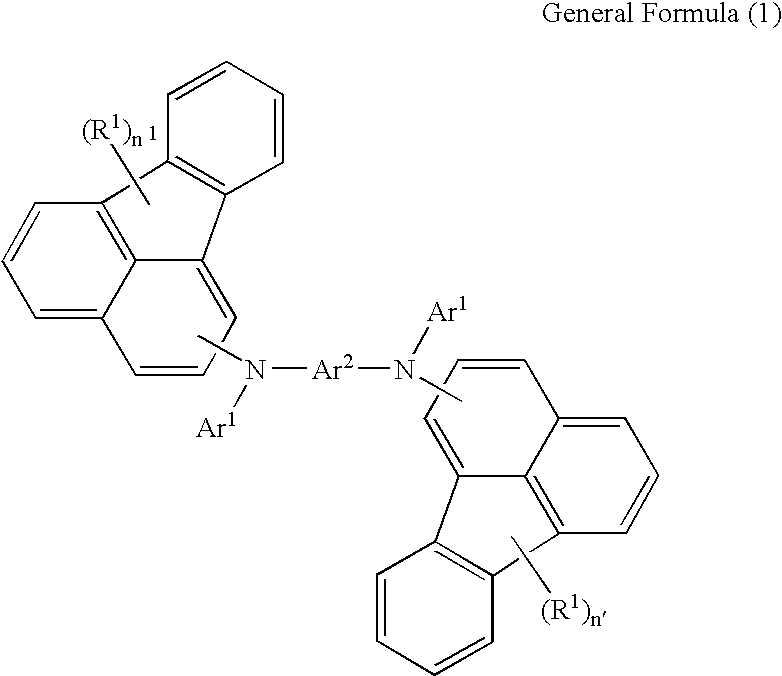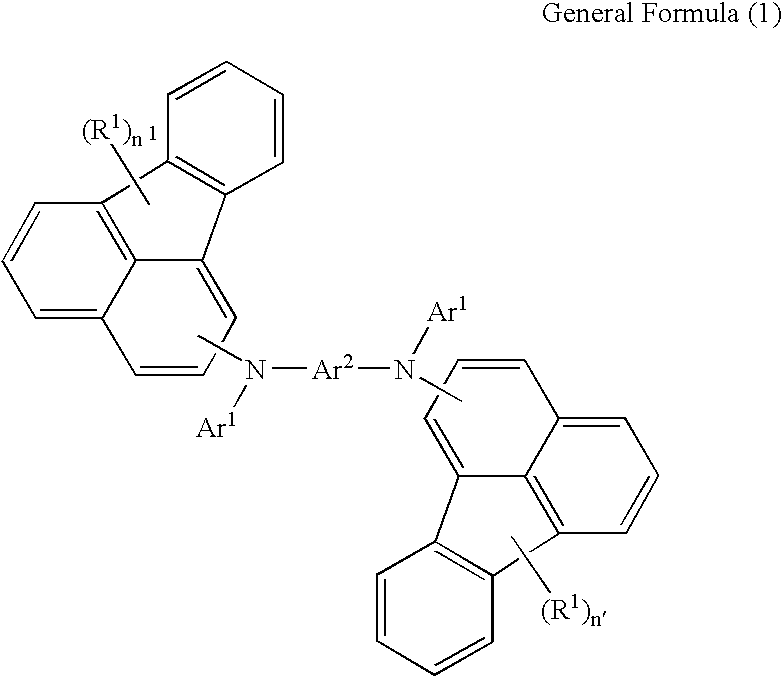Organic light-emitting material and method for producing an organic material
- Summary
- Abstract
- Description
- Claims
- Application Information
AI Technical Summary
Benefits of technology
Problems solved by technology
Method used
Image
Examples
example 1
[0154] With respect to the organic light-emitting material represented by the structural formula (1) synthesized in Example 1, the fluorescent quantum yield was as high as 0.77. The difference between the crystallization temperature (Tc) and the glass transition temperature (Tg) is as large as 69° C., which confirms that the material has excellent amorphous properties. Further, with respect to the organic electroluminescent element using the material of the structural formula (1) as an organic light-emitting material, the chromaticity in a normal structure is (0.358, 0.598), which indicates that green light emission with high purity close to the sRGB standard could be achieved, and the chromaticity in a resonance structure is (0.285, 0.677), which indicates that green light emission with high purity close to the NTSC standard could be achieved. In addition, it is found that the organic electroluminescent element using the organic light-emitting material represented by the structural...
example 2
[0155] With respect to the organic light-emitting material represented by the structural formula (2)-p synthesized in Example 2, the fluorescent quantum yield was as high as 0.75. The difference between the crystallization temperature (Tc) and the glass transition temperature (Tg) is as large as 73° C., which confirms that the material has excellent amorphous properties. Further, with respect to the organic electroluminescent element using the material of the structural formula (2)-p as an organic light-emitting material, the chromaticity in a normal structure is (0.400, 0.572), which indicates that green light emission with high purity close to the sRGB standard could be achieved, and the chromaticity in a resonance structure is (0.359, 0.627), which indicates that green light emission with high purity close to the NTSC standard could be achieved. In addition, it is found that the organic electroluminescent element using the organic light-emitting material represented by the struct...
example 3
[0156] With respect to the organic light-emitting material represented by the structural formula (2)-m synthesized in Example 3, the fluorescent quantum yield was as high as 0.69. The difference between the crystallization temperature (Tc) and the glass transition temperature (Tg) is as large as 91° C., which confirms that the material has very excellent amorphous properties. Further, with respect to the organic electroluminescent element using the material of the structural formula (2)-m as an organic light-emitting material, the chromaticity in a normal structure is (0.359, 0.604), which indicates that green light emission with high purity close to the sRGB standard could be achieved, and the chromaticity in a resonance structure is (0.290, 0.681), which indicates that green light emission with high purity close to the NTSC standard could be achieved. In addition, it is found that the organic electroluminescent element using the organic light-emitting material represented by the s...
PUM
| Property | Measurement | Unit |
|---|---|---|
| Efficiency | aaaaa | aaaaa |
| Purity | aaaaa | aaaaa |
Abstract
Description
Claims
Application Information
 Login to View More
Login to View More - R&D
- Intellectual Property
- Life Sciences
- Materials
- Tech Scout
- Unparalleled Data Quality
- Higher Quality Content
- 60% Fewer Hallucinations
Browse by: Latest US Patents, China's latest patents, Technical Efficacy Thesaurus, Application Domain, Technology Topic, Popular Technical Reports.
© 2025 PatSnap. All rights reserved.Legal|Privacy policy|Modern Slavery Act Transparency Statement|Sitemap|About US| Contact US: help@patsnap.com



